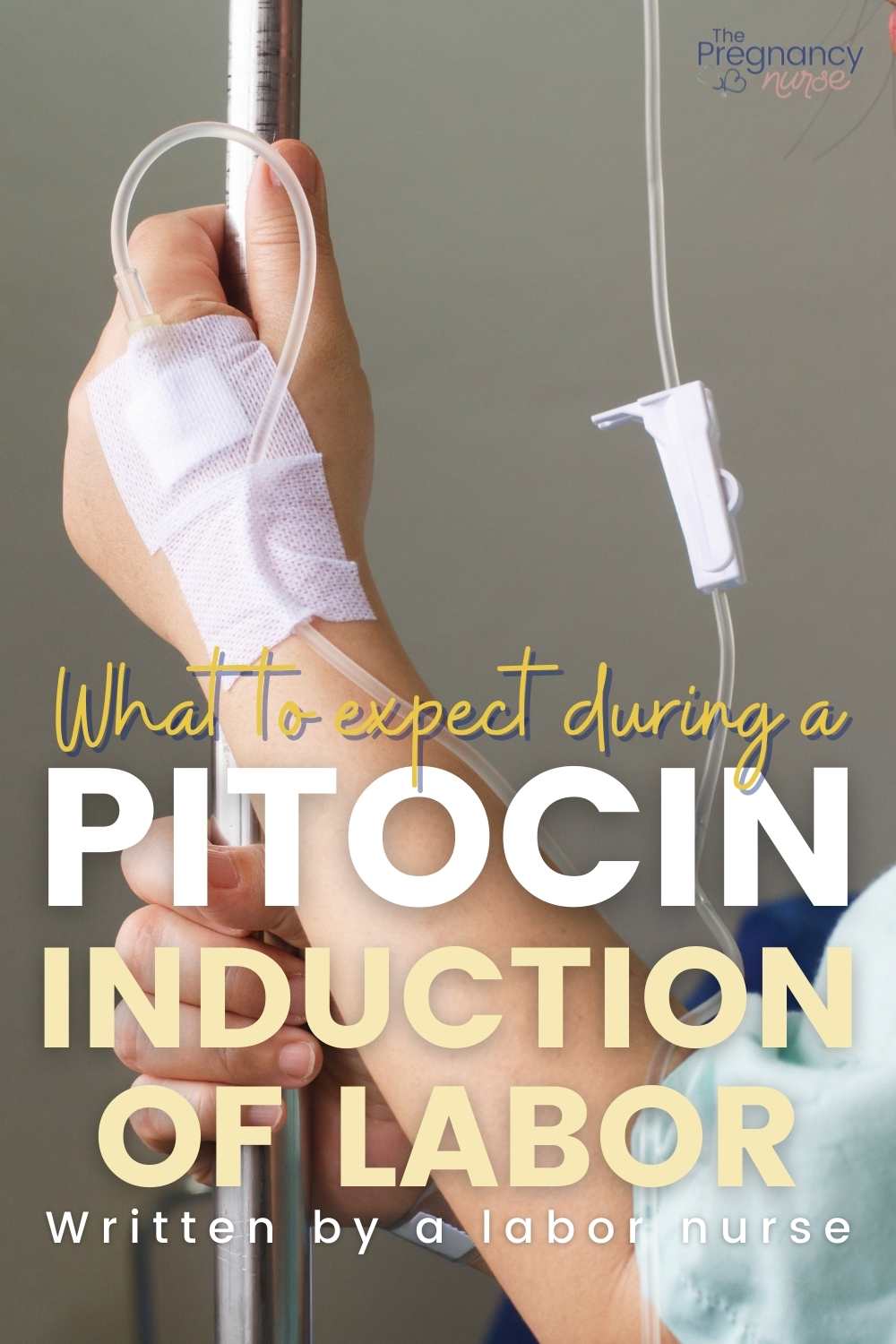Did you know that Pitocin is the most common drug used to induce labor? If you’re considering using Pitocin to induce labor, it’s important to understand what to expect. This blog post will provide an overview of a Pitocin induction, including what happens during the process and potential side effects. Keep reading for more information on using Pitocin to induce labor.

Before we get started, who am I — and why am I an “expert”?
Hi, I’m Hilary — The Pregnancy Nurse 👩⚕️. I have been a nurse since 1997 and I have 20 years of OB nursing experience, I am also the curly head behind Pulling Curls and The Online Prenatal Class for Couples. 🩺 I have started literally THOUSANDS of inductions, and educated millions of moms on what to expect. I have also had an induction of my own as well. So, I’m a pretty great source.\Before we start, grab my hospital packing list:
Inductions can be confusing… and I totally recommend a prenatal class if you’re planning on an induction. If your induction is tomorrow you can join me real fast in Inductions Made Easy to quickly get on top of what to expect tomorrow!
What is Pitocin and how does it work to induce labor
Pitocin is a synthetic version of oxytocin, which causes the uterus to contract. When given intravenously, Pitocin can speed up labor by stimulating uterine contractions. It can also be used to help control bleeding after childbirth.
How is Pitocin administered – through an IV or a shot
Pitocin can be given either through the IV or as a shot (most often in the leg). When Pitocin is given in these ways, it can cause the uterus to contract more regularly and intensely than it would naturally. This can help to speed up labor.
My friend Crystal came on the podcast to chat about her induction without an epidural:
Most labor and delivery units require it to be given via IV for induction in the US.
SO many people wonder how the whole process will work. This is why I love this class. It has a whole chapter on what to expect during an induction that eases SO many fears!
What are the side effects of Pitocin?
The side effects of Pitocin can vary depending on how the drug is administered. When given intravenously, Pitocin can cause the uterus to contract more regularly and intensely than it would naturally. This can help to speed up labor. However, it can also cause certain side effects, such as:
- Nausea
- Headaches
- Dizziness
- Increased blood pressure
- Increased heart rate
- Anxiety or restlessness
When given as a shot, Pitocin can also cause:
- Muscle aches or spasms
- Pain at the injection site
Could I be allergic to Pitocin?
As Pitocin is a synthetic hormone — it is the same compound as oxytocin which our body makes naturally. However, some people can be sensitive to the additives used to keep it self stable. Your providers will start with a small dose, and watch for any signs of allergies.
Differences Between Pitocin & Oxytocin
Like I said — chemically, Pitocin and Oxytocin couldn’t be distinguished from each other. But there are ways that they differ (and I’ve read a LOT about this after wondering how they work differently, so this is interesting stuff):
Oxytocin is released near your brain by the hypothalamus. That means it can affect your brain in ways that PITOCIN can’t because Pitocin can’t cross the blood brain barrier into the spinal fluid. Normally, oxytocin is considered the love hormone, so there can be positive feeling associated with labor and how things are progressing, that you won’t get with Pitocin.
Oxytocin is released in waves. So you’ll have harder contractions for a bit and then they abate, vs how we give Pitocin is 2 mu and then 4 mu and then 6 mu until we see your contractions in a good pattern. I wish we had a cool bump that would do it in bursts like the hypothalamus does, but that’s not what we have as of yet.
So, those are just a couple of ways in which they differ — but yes, chemically, they’re exactly the same.
Check out my post on ways to increase oxytocin when you’re in labor (because you can still release oxytocin even if we’re sending Pitocin into you.
What are the risks and benefits associated with Pitocin induction?
Obviously, the benefit is a delivery of the infant sooner than it would be if they didn’t use the medication.
Pitocin induction can cause a number of risks, including an increased risk of delivery complications, such as cesarean section. Pitocin can also cause the uterus to contract more forcefully than it would naturally, which can lead to pain and an increased risk of delivery complications, including possible uterine rupture (where it contracts so hard it rips itself).
With the uterus contracting too hard or too often — this can cause the baby’s heart rate to decrease.
What are Hospital Policies Relating to a Pitocin Induction of Labor?
While every hospital varies, the policies relating to a Pitocin induction of labor include:
- Constant fetal monitoring (can’t be intermittent)
- Can only increase the dosage by a certain amount by a certain amount of time (so, like up by 2 every 30 minutes)
- Patient may need to be NPO (meaning you can’t eat anything or just have clear liquids)
While normal hospital policies can mostly be side-stepped, in this case the nurse may stop the induction of labor if they aren’t able to have certain things happen (especially fetal monitoring).
How long til’ labor starts with Pitocin?
Most often you start to see some contractions right away, they may not be very firm or make your cervix open, but they are most often at least “there”.
Some people wonder how much Pitocin they will get, and I will say that it really varies on the person. Some people are in a great contraction pattern with just with 2 mili-units, but some people take upwards of 20. It’s different for everyone.
How long will labor be induced with Pitocin?
The length of labor can vary depending on a number of factors, including how Pitocin is administered and how sensitive the woman’s body is to the drug. In general, though, Pitocin-induced labor can last anywhere from a few hours to several days. It’s important to keep in mind that this is just an average.
As with most “trips”, it depends on where you start. We give where you are “starting” a bishop’s score. The #’s in the score are from your vaginal exam.
- Where your cervix is (far in the back or in the front)
- How soft your cervix is (called consistency)
- How open your cervix is (how dilated you are)
- How thick your cervix is (called effacement)
- How far into your pelvis the baby’s head is (called station)
Most often as you get closer to your due date this “score” is higher (meaning you’re more ready for your induction) than someone who has medical reasons for their labor induction.
What other things can speed up labor?
Some other things that can speed up labor include:
- Walking around and moving around as much as possible
- Staying hydrated
- Eating light, healthy foods
- Using relaxation techniques, such as deep breathing or visualization to help cope with contractions and labor
- Listening to music or having a massage from your partner or a loved one.
- Once you’re in the hospital many doctors feel that breaking your bag of water can speed up the delivery of your baby.
Will labor take longer on my first baby?
Most often the first few centimeters aren’t much different. But usually, the last 2-3 centimeters are shorter, and pushing time is greatly reduced if you have previously had a vaginal delivery.
If you are trying for a vaginal delivery after a cesarean, things may not be any different (as your birth canal won’t have been stretched with a previous baby).
There are a number of factors that can influence how long labor lasts, including the woman’s body and how sensitive she is to the Pitocin drug.
What are the chances of a successful vaginal birth after using Pitocin
There is no one-size-fits-all answer to this question, as the chances of a successful vaginal birth after using Pitocin can vary depending on a number of factors. However, in general, the chances of a successful vaginal birth after using Pitocin are relatively high.
Induction of labor does have a higher risk of a c-section than labor without Pitocin, and you should definitely talk to your provider about those risks and if the benefit of an earlier delivery is worth it (vs waiting for spontaneous labor).
How will I know if Pitocin is working
If Pitocin is working, you will likely start to feel more contractions. These contractions may be more intense than normal labor contractions, and they may come at regular intervals. You should communicate with your providers to let them know how you’re feeling and whether the contractions are getting stronger or more frequent.
Are medical providers careful with Pitocin?
Yes, medical providers are typically very careful when administering Pitocin, as it can cause pain and increase the risk of delivery complications. Every hospital has a specific policy about the use of Pitocin.
What other medications can be used for induction of labor instead of Pitocin?
Some other medications that can be used for induction of labor include:
These are cervical ripening agents used to soften your cervix and get it to a certain point before starting “harder” Pitocin contractions.
Other methods of induction can include:
Stripping the membranes: This is when your provider gently separates the amniotic sac from the wall of your uterus. This can cause the release of prostaglandins, which can help to induce labor.
Artificial rupture of the membranes (AROM): This is when your provider breaks your bag of water to induce labor.
Foley Bulb: Your provider will insert a balloon into your cervix to manually open it.
What are some natural ways to get induced?
Please talk with your provider before trying any of these methods…. many are not safe (especially prior to 37 weeks gestation). THIS IS NOT MEDICAL ADVICE, just information for you.
There are a few natural ways to get induced, including:
Resting – Many women go into labor naturally after getting plenty of rest. Try to relax and take it easy in the days leading up to your due date.
Walking – Walking can help stimulate the baby to move down into the birth canal. Walking also helps keep you limber and can help reduce pregnancy aches and pains. Movement, including rotating your hips on a birth ball can do something similar.
Sex – Some women find that having sex or using other forms of sexual stimulation in the days leading up to labor can help kickstart the process. However, if you are at all concerned about going into labor prematurely, it is best to avoid this.
Herbal remedies – There are a number of natural herbs and supplements that some women use to help stimulate labor, including evening primrose oil, red raspberry leaf tea, and castor oil. However, there is not much research to support their effectiveness, so it is important to speak with your provider before trying any herbal remedies.
Acupuncture – Some women find that acupuncture can help to stimulate labor. Again, there is not much research to support this, but it may be worth a try if you are looking for a natural way to get induced.
Stimulating the nipples – Nipple stimulation can help to release the hormone oxytocin, which is a hormone that helps to stimulate labor. If you choose to try this, make sure you talk to your doctor beforehand.
However, ultimately when you and your provider decide it is safest/best for your baby to be born soon — using controlled things like medication is often the safest for mom and baby (rather than herbal remedies or castor oil — which I do NOT recommend at all).
I actually have a guide all about how to go into labor if you’re looking to get that baby out sooner rather than later!
Reasons for a Pitocin Induction
There are a number of reasons why your doctor may recommend a Pitocin induction, including:
- Your amniotic sac has broken but labor has not started on its own (once your water breaks it is important that the baby comes soon as there is a risk of infection).
- You are overdue (post-term).
- Your baby is showing signs of distress.
- You have a high-risk pregnancy.
- You have a history of delivering early.
- You have certain medical conditions, such as diabetes or high blood pressure.
These are certainly not all the reasons, so be sure to talk with your provider about the reason you are being induced.
What else is Pitocin used for besides an induction?
Pitocin can also be used to speed up labor once it has started, as well as to stop bleeding after delivery (called a postpartum hemorrhage when it is a lot of bleeding).
How many weeks of pregnancy do I need to be for a Pitocin induction?
Your medical professionals will weigh the potential risks vs the benefits of having the baby early. Prior to 39 weeks, there must be a medical reason for the induction of labor. The earlier you are being induced, the more severe the medical issue will need to be (to compensate for possible early delivery of the baby). Types of pregnancy complications that would cause an early induction would be things like, IUGR, preeclampsia, diabetes, etc.
After 39 weeks (depending on hospital/bed availability) most providers will allow a woman to make an “elective” choice to be induced.
Can I still have a natural birth if I’m induced with Pitocin?
While it is possible to have a natural birth (“natural labor” in this case would be labor without pain medication) after being induced with Pitocin, the chances of this happening are not as high as if you were to go into labor naturally. Keep in mind that the risks associated with Pitocin induction can include an increased risk of delivery complications, such as cesarean section. It is important to talk to your doctor about your individual risk factors, as well as the pros and cons of using Pitocin versus going into labor naturally. Ultimately, the decision is up to you and your healthcare provider.
Whether or not to use Pitocin will depend on a number of factors, including your own preferences and medical history. It is important to talk to your doctor about the pros and cons of using Pitocin before making a decision.
Communication is truly going to be KEY in this process. This is why this class has a whole chapter on communicating with your provider. It gives real-life examples of those hard conversations you’re nervous to have.
- It can be done in just 3 hours
- It is created by a highly experienced L&D Nurse
- Created for couples to get both partners involved. I love what Tricia G had to say:
“My husband and I loved the course and all of the extra bonus printables that came along with it. Hilary has a great personality and made the sessions easy to follow along and kept our attention!”
Save 10% with coupon code PREGNURSE.
And, if you feel like you don’t have time for a full class, come join me in Labor Made Easy where we can get you prepared for your induction in the nick of time!







 Signs You Passed Your Glucose Screening Test During Pregnancy
Signs You Passed Your Glucose Screening Test During Pregnancy
